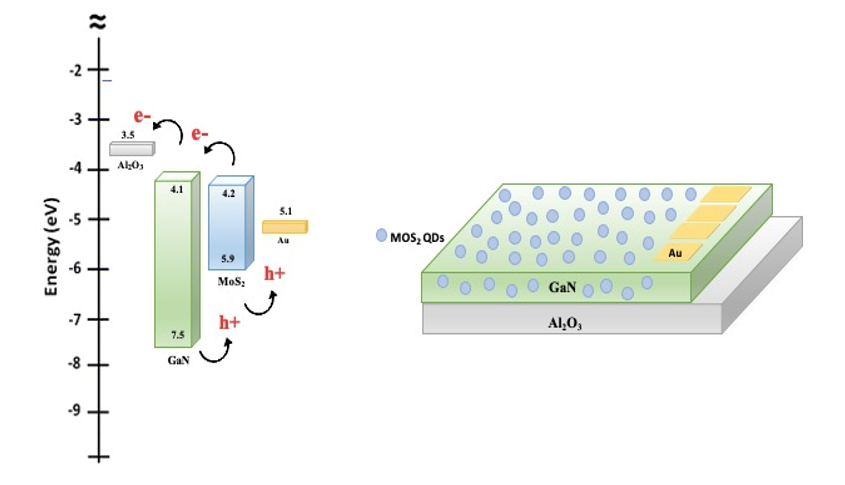Video Article Open Access
Photodetector based on n-MoS2 Quantum Dots/p-GaN with High Responsivity
Yasmeen Khoja1,*, Maymunah Alwehaibi1, Reem Alghamdi1, Fahdah Alsuhaibani1, Manar Alshatwi2
1Departement of Physics, College of Science Princess Nourah bint Abdulrahman University, Riyadh, 84428, Saudi Arabia
2Department of Physics, College of Science, University of Jeddah, Jeddah 21589, Saudi Arabia
Vid. Proc. Adv. Mater., Volume 3, Article ID 2208329 (2022)
DOI: 10.5185/vpoam.2022.08329
Publication Date (Web): 10 Mar 2023
Copyright © IAAM
Graphical Abstract

Abstract
Transition metal dichalcogenides (TMDs)-based photodetectors have been widely documented in the literature, with molybdenum disulfide (MoS2) being the most thoroughly investigated for photodetection applications. The main MoS2 features direct bandgap transition in low-dimensional structures, high light-matter interaction, and good carrier mobility when combined with the ability to fabricate. The material MoS2 has sparked interest in the field of optoelectronics. In this work, we have successfully fabricated n-Mos2\p-Gan heterojunction photodetector with high performance. Were MoS2 quantum dots (QDs) synthesized by using the liquid exfoliation method. characterized by X-ray diffraction (XRD), fluorescence emission spectra (FES), UV spectroscopy, and scanning electron microscopy (SEM), energy dispersive X-Ray (EDX). Transmission electron microscopy (TEM) and electrical (I-V) characterization appeared the responsivity and detectivity of the photodetectors. The QDs are spray-coated onto p-GaN Substrate. that photodetector is sensitive to infrared and deep ultraviolet (190-340 nm), and fluorescence emission spectra of MoS2 QDs excitation peak investigate at 325 nm which is successfully confirmed extract MoS2 QDs. And high responsivity, excellent detectivity. Furthermore, SEM images have shown the MoS2 QDs with sizes ranging from (~ 4-11 nm). The QDs observed have a nearly spherical shape with a homogenous distribution. this study proved a cost-effective design method, high responsiveness, long-term environmental stability, and opens up new avenues for developing low-cost and broadband based TMDs photoelectric devices.
Keywords
Molybdenum disulfide, GaN, photodetectors, Transition Metal Dichalcogenides (TMDs).
Acknowledgement
The authors express their gratitude to Princess Nourah bint Abdulrahman University Researchers Supporting Project (Grant No. PNURSP2022R11), Princess Nourah bint Abdulrahman University, Riyadh, Saudi Arabia.
Video Proceedings of Advanced Materials

Upcoming Congress



